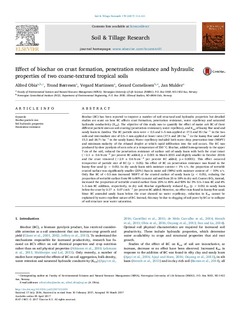| dc.contributor.author | Obia, Alfred | |
| dc.contributor.author | Børresen, Trond | |
| dc.contributor.author | Martinsen, Vegard | |
| dc.contributor.author | Cornelissen, Gerard | |
| dc.contributor.author | Mulder, Jan | |
| dc.date.accessioned | 2018-11-22T09:28:07Z | |
| dc.date.available | 2018-11-22T09:28:07Z | |
| dc.date.created | 2017-04-06T09:18:24Z | |
| dc.date.issued | 2017 | |
| dc.identifier.citation | Soil & Tillage Research. 2017, 170 114-121. | |
| dc.identifier.issn | 0167-1987 | |
| dc.identifier.uri | http://hdl.handle.net/11250/2574272 | |
| dc.description.abstract | Biochar (BC) has been reported to improve a number of soil structural and hydraulic properties but detailed studies are scant on how BC affects crust formation, penetration resistance, water repellency and saturated hydraulic conductivity (Ksat). The objective of this study was to quantify the effect of maize cob BC of three different particle sizes on soil crusting (penetration resistance), water repellency, and Ksat of loamy fine sand and sandy loam in Zambia. The BC particle sizes were <0.5 and 1–5 mm applied at 17.5 and 35 t ha−1 in the two soils and intermediate size of 0.5–1 mm applied at lower rates (17.5 and 28 t ha−1 in the loamy fine sand and 13.3 and 26.7 t ha−1 in the sandy loam). Water repellency included both water drop penetration time (WDPT) and minimum molarity of the ethanol droplet at which rapid infiltration into the soil occurs. The BC was produced by slow pyrolysis of corn cobs at a temperature of 350 °C. Biochar, added homogeneously to the upper 7 cm of the soil, reduced the penetration resistance of surface soil of sandy loam with both the crust intact (−2.1 ± 0.6 N cm−2 per percent BC added; p = 0.001 in March 2015 and slightly smaller in October 2014) and the crust removed (−2.9 ± 0.6 N cm−2 per percent BC added; p = 0.0001). This effect occurred irrespective of particle size of BC (p > 0.05). No effect of BC on penetration resistance was found in the loamy fine sand (p > 0.05). In dry sandy loam with moisture content <1% v/v, the proportion of wettable crusted surface was significantly smaller (25%) than in moist soil (98%) with moisture content of ∼ 10% v/v. Only fine BC of <0.5 mm increased WDPT of the crusted surface of sandy loam (p < 0.05), reducing the proportion of wettable surface from 98 to 80% in moist soil and from 25 to 18% in dry soil. Coarser BCs, instead, increased the proportion of wettable crusted surface from 25% to 45% and 90% for 3% 0.5–1 mm BC and 4% 1–5 mm BC addition, respectively, in dry soil. Biochar significantly reduced Ksat (p < 0.05) in sandy loam below the crust by 0.17 ± 0.07 cm h−1 per percent BC added. However, no effect was found in loamy fine sand. Since BC amended sandy loam below the crust showed no water repellency, reduction in Ksat cannot be explained by water-repellent nature of BC. Instead, this may be due to clogging of soil pores by BC or to collapse of soil structure near water saturation. | |
| dc.description.abstract | Effect of biochar on crust formation, penetration resistance and hydraulic properties of two coarse-textured tropical soils | |
| dc.language.iso | eng | |
| dc.title | Effect of biochar on crust formation, penetration resistance and hydraulic properties of two coarse-textured tropical soils | |
| dc.title.alternative | Effect of biochar on crust formation, penetration resistance and hydraulic properties of two coarse-textured tropical soils | |
| dc.type | Peer reviewed | |
| dc.type | Journal article | |
| dc.description.version | acceptedVersion | |
| dc.source.pagenumber | 114-121 | |
| dc.source.volume | 170 | |
| dc.source.journal | Soil & Tillage Research | |
| dc.identifier.doi | 10.1016/j.still.2017.03.009 | |
| dc.identifier.cristin | 1463968 | |
| cristin.unitcode | 7452,5,0,0 | |
| cristin.unitcode | 7452,5,2,0 | |
| cristin.unitname | Miljøteknologi - stab | |
| cristin.unitname | Forurensning og arealutvikling | |
| cristin.ispublished | true | |
| cristin.fulltext | postprint | |
| cristin.qualitycode | 1 | |
